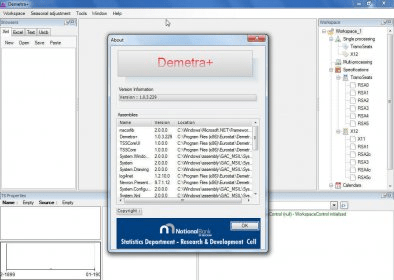Demetra Software Development
Demetra is the software developed by Shelyak Instruments to facilitate the implementation of Alpy 600 spectrograph, from image acquisitions to data reduction.
Convinced that it is thanks to the software that we can make spectroscopy more and more accessible, we are pleased to announce today the release of version 5.1 of Demetra for Alpy, which brings major changes to this tool.
Demetra is free and can be download here
Jeta logo designer crack pipes. Let’s have a review the main changes.
The Fundamental Rules of Software Engineering. 1) If you don t do a system architectural design with well-defined interfaces, integration will be a big mess.
Graphics in PNG, PDF and SVG format
It is now possible to produce graphics in PNG format, but also in PDF and SVG format (for easy editing in graphical software), directly from Demetra.These graphics are largely configurable, to adapt them to your need:
- Choice of colors, dimensions of graphics, titles, grids
- Possibility to add a 2D spectrum, in color or in black & white,
- Possibility to indicate specific lines (emission or absorption, etc…),
Here are some examples of Vega spectrum graphs, made from the demonstration data provided with the software:
When the graphics parameters are defined, they will then be applied to each data reduction;the generation of the graphics is now an integrated step in the data reduction process!
Enhanced Auto Spectral Calibration Tool
The wavelength calibration step is critical in the data reduction process.Since its creation, Demetra has integrated a proven automatic calibration tool.However, this step remained difficult to explain, or even to configure if necessary.In this new version of Demetra, we have greatly improved the interface of this tool, to give you even more control over your data.
A visual tool to better understand and master spectral calibration
At first, Demetra detects all the lines present in the calibration spectrum… there are many!
Demetra then looks for the best combination of lines corresponding to a set of reference lines, whose wavelengths are known (table, bottom right).The result is clear: the identified lines are displayed on the graph.This allows, in addition to the residual error value (RMS) to immediately check that the calibration has gone well.
An editor for reference lines
It may happen that some reference lines are poorly detected with your instrument, or there is the possibility of adding lines, to improve calibration accuracy.It is now possible to edit the list of lines to best adapt it to your observations:
Access to a reference document
Displaying the detected and identified lines is important, but it would be of little use if we do not have a reference spectrum at hand.It is now done: a PDF file showing the main lines of neon and argon at the resolution of the Alpy is accessible with a simple click.

A new algorithm for calibration line detection
In the calibration spectrum, there are many emission lines, but not all were usable until then. Indeed, bended lines were poorly detected (or rather a single line was detected for a double peak), making their use difficult in practice. We have integrated a new algorithm that now detects error-free split lines. This allows for the addition of reference lines, which improves both the robustness of the calibration and its accuracy.
The example below shows an area of the Ar-Ne spectrum with many split lines – Demetra detects them perfectly!
Manual Calibration Tool Enhancement
Although auto-calibration works very well, there are cases where manual calibration is preferred.Demetra now allows it with a much more advanced tool than in previous versions:
Explicit intermediate results
During the data reduction calculation, Demetra displays all intermediate results (log file).We have greatly improved this function in order to highlight all the information – and only this – which is of scientific interest.The result is a text that is more understandable, more relevant, and more useful in case of interruption of the reduction process.
Intermediate images are placed in a subdirectory
If you choose to keep the intermediate images during processing, these are very numerous (several tens of images per observation).In order to reduce the confusion that this may bring, Demetra now places them in a subdirectory bearing the name of the observation.This not only improves readability, but also makes it easy to clean up useless data: just delete this directory, no data that is in is critical!
For an increasingly simple spectroscopy
All these (and others, less visible, but many) developments in the software have in common to make the operation of spectroscopy more and more simple, fast and efficient – with no compromise on the quality of the scientific result obtained. Many of you now use Demetra – because more and more peopele is doing spectro – and it is your remarks from the ‘real life in the field’ that allow us to improve the software. It’s a never ending adventure, so we stay tuned to your experiences and feedback.
In the coming weeks, we will be putting online a new documentation in the form of video tutorials: it is when we show Demetra in action that it is the most spectacular!
I remind you that Demetra is free and includes demo images, so you can discover the software safely now!
Besides seasonal adjustment, JDemetra+ bundles other time series models that are useful in the production or analysis of economic statistics, including for instance outlier detection, nowcasting, temporal disaggregation or benchmarking.
From a technical point of view, JDemetra+ is a collection of reusable and extensible Java components, which can be easily accessed through a rich graphical interface. The software is a free and open-source software (FOSS) developed under the EUPL licence.
JDemetra+ has been officially recommended, since 2 February 2015, to the members of the ESS and the European System of Central Banks as software for seasonal and calendar adjustment of official statistics.